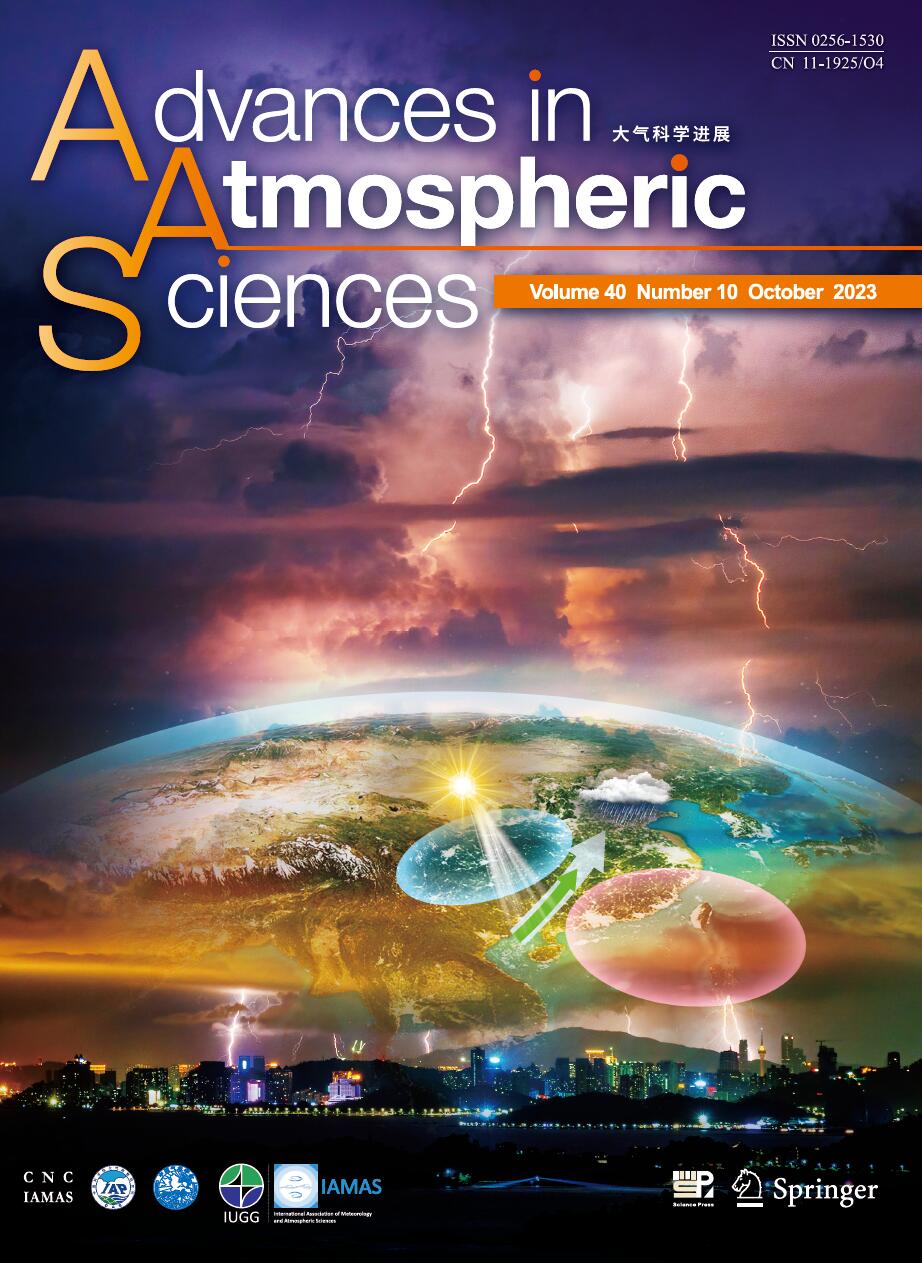| [1] |
ZHU Jieshun, SUN Zhaobo, ZHOU Guangqing,
2007: A Note on the Role of Meridional Wind Stress Anomalies and Heat Flux in ENSO Simulations, ADVANCES IN ATMOSPHERIC SCIENCES, 24, 729-738.
doi: 10.1007/s00376-007-0729-y
|
| [2] |
PENG Guliang, CAI Xuhui, ZHANG Hongsheng, LI Aiguo, HU Fei, Monique Y. LECLERC,
2008: Heat Flux Apportionment to Heterogeneous Surfaces\\[.1cm] Using Flux Footprint Analysis, ADVANCES IN ATMOSPHERIC SCIENCES, 25, 107-116.
doi: 10.1007/s00376-008-0107-4
|
| [3] |
Chengyan LIU, Zhaomin WANG, Bingrui LI, Chen CHENG, Ruibin XIA,
2017: On the Response of Subduction in the South Pacific to an Intensification of Westerlies and Heat Flux in an Eddy Permitting Ocean Model, ADVANCES IN ATMOSPHERIC SCIENCES, 34, 521-531.
doi: 10.1007/s00376-016-6021-2
|
| [4] |
Yang Haijun, Liu Qinyu, Jia Xujing,
1999: On the Upper Oceanic Heat Budget in the South China Sea: Annual Cycle, ADVANCES IN ATMOSPHERIC SCIENCES, 16, 619-629.
doi: 10.1007/s00376-999-0036-x
|
| [5] |
Yitian QIAN, Pang-Chi HSU, Chi-Han CHENG,
2017: Changes in Surface Energy Partitioning in China over the Past Three Decades, ADVANCES IN ATMOSPHERIC SCIENCES, 34, 635-649.
doi: 10.1007/s00376-016-6194-8
|
| [6] |
CHEN Xianyan, Masahide KIMOTO,
2009: Simulating Tropical Instability Waves in the Equatorial Eastern Pacific with a Coupled General Circulation Model, ADVANCES IN ATMOSPHERIC SCIENCES, 26, 1015-1026.
doi: 10.1007/s00376-009-8078-7
|
| [7] |
Qinyu LIU, Yiqun LU,
2016: Role of Horizontal Density Advection in Seasonal Deepening of the Mixed Layer in the Subtropical Southeast Pacific, ADVANCES IN ATMOSPHERIC SCIENCES, 33, 442-451.
doi: 10.1007/s00376-015-5111-x
|
| [8] |
Zhou Tianjun, Yu Rucong, Li Zhaoxin,
2002: ENSO-Dependent and ENSO-Independent Variability over the Mid-Latitude North Pacific: Observation and Air-Sea Coupled Model Simulation, ADVANCES IN ATMOSPHERIC SCIENCES, 19, 1127-1147.
doi: 10.1007/s00376-002-0070-4
|
| [9] |
LI Wanli, LU Shihua, FU Shenming, MENG Xianhong, H. C. NNAMCHI,
2011: Numerical Simulation of Fluxes Generated by Inhomogeneities of the Underlying Surface over the Jinta Oasisin Northwestern China, ADVANCES IN ATMOSPHERIC SCIENCES, 28, 887-906.
doi: 10.1007/s00376-010-0041-0
|
| [10] |
Boyin Huang, Zhengyu Liu,
2002: An OGCM Simulation of Seasonal and lnterannual Variabilities in the Surface-Layer Pacific of the Equatorial Band, ADVANCES IN ATMOSPHERIC SCIENCES, 19, 219-235.
doi: 10.1007/s00376-002-0018-8
|
| [11] |
Ye Zhuojia, Roger A. Pielke,
1995: A Parameterization of Bowen Ratio with Respect to Soil Moisture Availability, ADVANCES IN ATMOSPHERIC SCIENCES, 12, 449-474.
doi: 10.1007/BF02657005
|
| [12] |
Bo HAN, Shihua LÜ, Ruiqing LI, Xin WANG, Lin ZHAO, Cailing ZHAO, Danyun WANG, Xianhong MENG,
2017: Global Land Surface Climate Analysis Based on the Calculation of a Modified Bowen Ratio, ADVANCES IN ATMOSPHERIC SCIENCES, 34, 663-678.
doi: 10.1007/s00376-016-6175-y
|
| [13] |
Zhao Yanzeng, Hu Yuliang, Zhao Hongjie,
1984: INTEGRATION METHOD AND RATIO METHOD FOR RETRIEVING EXTINCTION COEFFICIENT FROM LIDAR SIGNALS, ADVANCES IN ATMOSPHERIC SCIENCES, 1, 53-75.
doi: 10.1007/BF03187616
|
| [14] |
Kang Hongwen, Gu Xiangqian, Liu Chongjian, Wang Pengyun,
2002: Adaptive Grid Technique Based on the Variational Principle and Its Weight Functions, ADVANCES IN ATMOSPHERIC SCIENCES, 19, 705-718.
doi: 10.1007/s00376-002-0010-3
|
| [15] |
Wang Yunfeng, Wu Rongsheng, Wang Yuan, Pan Yinong,
2000: A Simple Method of Calculating the Optimal Step Size in 4DVAR Technique, ADVANCES IN ATMOSPHERIC SCIENCES, 17, 433-444.
doi: 10.1007/s00376-000-0034-5
|
| [16] |
PAN Naixian, LI Chengcai,
2008: Deduction of the Sensible Heat Flux from SODAR Data, ADVANCES IN ATMOSPHERIC SCIENCES, 25, 253-266.
doi: 10.1007/s00376-008-0253-8
|
| [17] |
GAO Zhiqiu, BIAN Lingen, WANG Jinxing, LU Longhua,
2003: Discussion on Calculation Methods of Sensible Heat Flux during GAME/Tibet in 1998, ADVANCES IN ATMOSPHERIC SCIENCES, 20, 357-368.
doi: 10.1007/BF02690794
|
| [18] |
Lei LIU, Guihua WANG, Ze ZHANG, Huizan WANG,
2022: Effects of Drag Coefficients on Surface Heat Flux during Typhoon Kalmaegi (2014), ADVANCES IN ATMOSPHERIC SCIENCES, 39, 1501-1518.
doi: 10.1007/s00376-022-1285-1
|
| [19] |
LAN Weiren, HUANG Sixun, XIANG Jie,
2004: Generalized Method of Variational Analysis for 3-D Flow, ADVANCES IN ATMOSPHERIC SCIENCES, 21, 730-740.
doi: 10.1007/BF02916370
|
| [20] |
Ying NA, Riyu LU, Bing LU, Min CHEN, Shiguang MIAO,
2019: Impact of the Horizontal Heat Flux in the Mixed Layer on an Extreme Heat Event in North China: A Case Study, ADVANCES IN ATMOSPHERIC SCIENCES, 36, 133-142.
doi: 10.1007/s00376-018-8133-3
|















 AAS Website
AAS Website 
 AAS WeChat
AAS WeChat 
 DownLoad:
DownLoad: